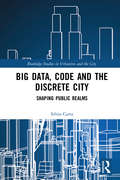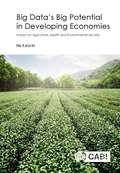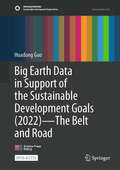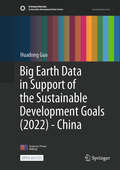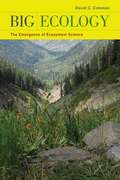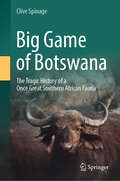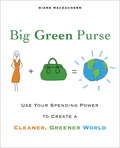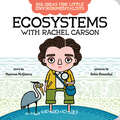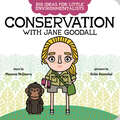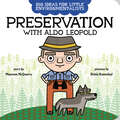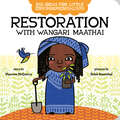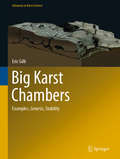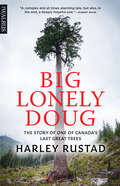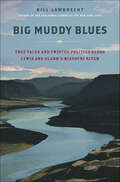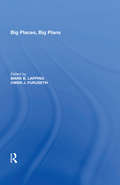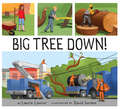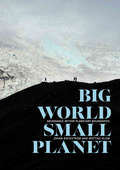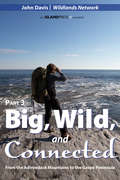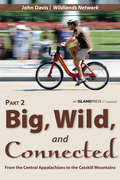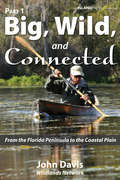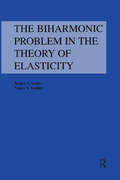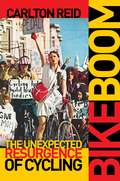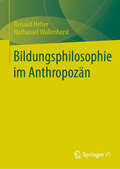- Table View
- List View
Big Data, Code and the Discrete City: Shaping Public Realms (Routledge Studies in Urbanism and the City)
by Silvio CartaBig Data, Code and the Discrete City explores how digital technologies are gradually changing the way in which the public space is designed by architects, managed by policymakers and experienced by individuals. Smart city technologies are superseding the traditional human experience that has characterised the making of the public space until today. This book examines how computers see the public space and the effect of algorithms, artificial intelligences and automated processes on the human experience in public spaces. Divided into three parts, the first part of this book examines the notion of discreteness in its origins and applications to computer sciences. The second section presents a dual perspective: it explores the ways in which public spaces are constructed by the computer-driven logic and then translated into control mechanisms, design strategies and software-aided design. This perspective also describes the way in which individuals perceive this new public space, through its digital logic, and discrete mechanisms (from Wi-Fi coverage to self-tracking). Finally, in the third part, this book scrutinises the discrete logic with which computers operate, and how this is permeating into aspects of city life. This book is valuable for anyone interested in urban studies and digital technologies, and more specifically in big data, urban informatics and public space.
Big Data’s Big Potential in Developing Economies: Impact on Agriculture, Health and Environmental Security
by Nir KshetriBig data involves the use of sophisticated analytics to make decisions based on large-scale data inputs. It is set to transform agriculture, environmental protection and healthcare in developing countries. This book critically evaluates the developing big data industry and market in these countries and gives an overview of the determinants, performance and impacts. It provides a detailed analysis of technology creation, technology infrastructures and human skills required to utilize big data while discussing novel applications and business models that make use of it to overcome healthcare barriers. The book also offers an analysis of big data's potential to improve environmental monitoring and protection where it is likely to have far-reaching and profound impacts on the agricultural sector. A key question addressed is how gains in agricultural productivity associated with big data will benefit smallholder farmers relative to global multinationals in that sector. The book also probes big data's roles in the creation of markets that can improve the welfare of smallholder farmers. Special consideration is given to big data-led transformation of the financial industry and discusses how the transformation can increase small-holder farmers' access to finance by changing the way lenders assess creditworthiness of potential borrowers. It also takes a look at data privacy and security issues facing smallholder farmers and reviews differences in such issues in industrialized and developing countries. The key ideas, concepts and theories presented are explored, illustrated and contrasted through in-depth case studies of developing world-based big data companies, and deployment and utilization of big data in agriculture, environmental protection and healthcare.
Big Earth Data in Support of the Sustainable Development Goals (Sustainable Development Goals Series)
by Huadong GuoThis open access book showcases the innovative practices of Big Earth Data methods through a collection of global comprehensive case studies to monitor and evaluate indicators for seven SDGs, i.e., zero hunger (SDG 2), clean water and sanitation (SDG 6), affordable and clean energy (SDG 7), sustainable cities and communities (SDG 11), climate action (SDG 13), life below water (SDG 14), life on land (SDG 15), and to analyzes the interactions among multiple SDGs indicators. The emphasis on Big Earth Data is highly relevant within the context of growing global challenges. Disaster risk mitigation, climate change, global food security, resource management, and environmental challenges all are interlinked through earth systems and processes that are independent of human constructs. Therefore these case studies highlight methods and practices of spatial information mining and integrated SDG evaluation, which include evaluating the synergy and trade-off relationships among the SDGs in the context of their correlations; simulating multiple indicators’ interactions in environmental, economic, and social scenarios in the context of their temporal variations; designing integrated evaluations of regional SDGs in the context of experience with the study of multiple indicators. Big Earth Data therefore has the potential to support informed policy and decision support at global, regional, and local scales.
Big Earth Data in Support of the Sustainable Development Goals (Sustainable Development Goals Series)
by Huadong GuoThis open access book showcases the innovative practices of Big Earth Data methods through a collection of comprehensive case studies from China to monitor and evaluate indicators for seven SDGs, i.e., zero hunger (SDG 2), clean water and sanitation (SDG 6), affordable and clean energy (SDG 7), sustainable cities and communities (SDG 11), climate action (SDG 13), life below water (SDG 14), life on land (SDG 15), and to analyze the interactions among multiple SDGs indicators. The emphasis on Big Earth Data is highly relevant within the context of growing global challenges. Disaster risk mitigation, climate change, global food security, resource management, and environmental challenges all are interlinked through earth systems and processes that are independent of human constructs. Therefore, these case studies highlight methods and practices of spatial information mining and integrated SDG evaluation, which include evaluating the synergy and trade-off relationships among the SDGs in the context of their correlations; simulating multiple indicators’ interactions in future environmental, economic and social scenarios in the context of their temporal variations; designing integrated evaluations of regional SDGs in the context of experience with the study of multiple indicators. Big Earth Data therefore has the potential to support informed policy and decision support at global, regional, and local scales.
Big Ecology
by David C. ColemanIn Big Ecology, David C. Coleman documents his historically fruitful ecological collaborations in the early years of studying large ecosystems in the United States. As Coleman explains, the concept of the ecosystem--a local biological community and its interactions with its environment--has given rise to many institutions and research programs, like the National Science Foundation's program for Long Term Ecological Research. Coleman's insider account of this important and fascinating trend toward big science takes us from the paradigm of collaborative interdisciplinary research, starting with the International Geophysical Year (IGY) of 1957, through the International Biological Program (IBP) of the late 1960s and early 1970s, to the Long-Term Ecological Research (LTER) programs of the 1980s.
Big Game of Botswana: The Tragic History of a Once Great Southern African Fauna
by Clive SpinageQuoting contemporary accounts from hunters, missionaries and traders from the early nineteenth century onwards, this book illustrates the ecology of the country as it was emphasizing its rich large mammal fauna, its decline from increasing aridity of the country, it destruction by hunters, by disease, and most importantly, destruction of its vast herds, notably of wildebeest, due to the developing beef export economy and the erection of veterinary cordon fences depriving the large game of migration routes in times of drought. Once possessing one of the greatest animal displacements in Africa, with huge migrations of antelope, this book underlines the reality that the fauna of Botswana today is but a tiny remnant of what was perhaps once one of the the greatest spectacles of big game on earth. It shows how the decline came about -- and the controls exercised by tribal chiefs illustrating the indigenous peoples’ attitudes, and eventual protective measures both tribal and statutory. Whereas the pessimistic predictions of extinction at the end of the nineteenth century have happily not come true, nonetheless, the continued existence of this once great fauna is increasingly threatened by climate change threatening an already fragile balance, and human population increase with its increasing economic demands and changes in land use. The study fills a gap in the literature of African wildlife conservation and is distinctive by drawing upon a rich historical background.
Big Green Purse: Use Your Spending Power to Create a Cleaner, Greener World
by Diane MaceachernProtecting our environment is one of the biggest issues facing our planet today. But how do we solve a problem that can seem overwhelming-even hopeless? As Diane MacEachern argues in Big Green Purse, the best way to fight the industries that pollute the planet, thereby changing the marketplace forever, is to mobilize the most powerful consumer force in the world-women. MacEachern's message is simple but revolutionary. If women harness the "power of their purse" and intentionally shift their spending money to commodities that have the greatest environmental benefit, they can create a cleaner, greener world. Spirited and informative, this book: - targets twenty commodities-cars, cosmetics, coffee, food, paper products, appliances, cleansers, and more-where women's dollars can make a dramatic difference; - provides easy-to-follow guidelines and lists so women can choose the greenest option regardless of what they're buying, along with recommended companies they should support; - encourages women to spend wisely by explaining what's worth the premium price some green products cost, what's not, and when they shouldn't spend money at all; and - differentiates between products that are actually "green" and those that are simply marketed as "ecofriendly." Whether readers want to start with small changes or are ready to devote the majority of their budget to green products, MacEachern offers concrete and immediate ways that women can take action and make a difference. Empowering and enlightening, Big Green Purse will become the "green shopping bible" for women everywhere who are asking, "What can I do? "
Big Ideas For Little Environmentalists: Ecosystems with Rachel Carson (Big Ideas for Little Environmentalists)
by Maureen McQuerryDiscover Rachel Carson's big ideas about protecting ecosystems and ways even the youngest kids can help, too! Even little children can make a positive impact on the environment. Rachel Carson was an environmentalist who studied the way the land, plants, and animals interact with each other, beginning when she was a child. She noticed that everything is connected, and all of nature must stay healthy for living things to thrive. When she realized that the chemicals people used outdoors were making plants, animals, and even other people sick, she began teaching others about the ecosystems, and how we must take care of them to keep the Earth balanced. Kids will see, through Rachel&’s curiosity and passion for all creatures, that even seemingly small choices can have big consequences on the world around them. Look for all of the books in the Big Ideas for Little Environmentalists series: Conservation with Jane Goodall, Restoration with Wangari Maathai, and Preservation with Aldo Leopold.
Big Ideas for Little Environmentalists: Conservation with Jane Goodall (Big Ideas for Little Environmentalists)
by Maureen McQuerryDiscover Jane Goodall's big ideas about conserving habitats and ways even the youngest kids can help, too! Even little children can make a positive impact on the environment. Jane Goodall has dedicated her life to studying chimpanzees, and realized that sometimes people hurt the places where animals have always lived. She began to teach others how we can enjoy nature while also making sure that the homes of animals aren&’t suffering. Kids will come away from this book with questions about what animal habitats they can care for in their own community, and how conservation work makes sure all people and animals have a healthy home. Look for the other books in the Big Ideas for Little Environmentalists series: Restoration with Wangari Maathai, Preservation with Aldo Leopold, and Ecosystems with Rachel Carson.
Big Ideas for Little Environmentalists: Preservation with Aldo Leopold (Big Ideas for Little Environmentalists)
by Maureen McQuerryDiscover Aldo Leopold's big ideas about preserving nature and ways even the youngest kids can help, too!Little children can make a big impact on the environment. Aldo Leopold transformed his childhood love for nature into a life dedicated to protecting and preserving the environment. He encouraged the idea of keeping wilderness areas untouched, so that all people could visit areas free of human interference. Kids will come away from this book excited about the nature they have access to and how to help preserve other wilderness areas. Look for all of the books in the Big Ideas for Little Environmentalists series: Conservation with Jane Goodall, Restoration with Wangari Maathai, and Ecosystems with Rachel Carson.
Big Ideas for Little Environmentalists: Restoration with Wangari Maathai (Big Ideas for Little Environmentalists)
by Maureen McQuerryDiscover Wangari Maathai's big ideas about restoring nature and ways even the youngest kids can help, too! Even little children can make a positive impact on the environment. Wangari Maathai grew up in Kenya, and her childhood was spent playing beneath mugumo fig trees. Over time, most of the trees in her area were cleared and she noticed how that made many people and animals suffer. Wangaari realized that trees are important for the health of the land and all who live on it, so she worked to plant millions of trees to make the land healthy again. Kids will begin to see through Wangaari that it is never too late to help restore damaged land back to what it once was, and they can help their community take care of struggling environments. Look for all of the books in the Big Ideas for Little Environmentalists series: Conservation with Jane Goodall, Preservation with Aldo Leopold, and Ecosystems with Rachel Carson.
Big Karst Chambers: Examples, Genesis, Stability (Advances in Karst Science)
by Eric GilliThis book documents and describes 32 natural caves from France and around the globe that have a width larger than 50 m, including data on the largest underground chamber in the world: Sarawak Chamber. Artificial caves are not able to be constructed at these volumes and most of these naturally forming chambers had never been surveyed before with little geological data available. Methodologies for studying these large volume Karst chambers are described and for each site, a survey, a geomorphological sketch, a description and photographic images are provided. The process of the mechanical transportation by underground running water, of an insoluble but erodible rock located below thick limestone roofs via digging, scouring and racking are explained through these example to clarify the genesis of the largest volumes in the world. The purpose of this study was to estimate whether these natural contexts could be transposed to the digging of artificial caverns to accommodate underground nuclear power plants. Indeed, the comparison of the effects of the Lucens nuclear accident with those of Chernobyl and Fukushima shows the whole interest of an underground solution. These examples of natural chambers indisputably show that this is possible.
Big Lonely Doug: The Story of One of Canada’s Last Great Trees
by Harley RustadIn the tradition of John Vaillant’s modern classic The Golden Spruce comes a story of the unlikely survival of one of the largest and oldest trees in Canada.On a cool morning in the winter of 2011, a logger named Dennis Cronin was walking through a stand of old-growth forest near Port Renfrew on Vancouver Island. He came across a massive Douglas fir the height of a twenty-storey building. Instead of allowing the tree to be felled, he tied a ribbon around the trunk, bearing the words “Leave Tree.” The forest was cut but the tree was saved. The solitary Douglas fir, soon known as Big Lonely Doug, controversially became the symbol of environmental activists and their fight to protect the region’s dwindling old-growth forests.Originally featured as a long-form article in The Walrus that garnered a National Magazine Award (Silver), Big Lonely Doug weaves the ecology of old-growth forests, the legend of the West Coast’s big trees, the turbulence of the logging industry, the fight for preservation, the contention surrounding ecotourism, First Nations land and resource rights, and the fraught future of these ancient forests around the story of a logger who saved one of Canada's last great trees.
Big Muddy Blues: True Tales and Twisted Politics Along Lewis and Clark's Missouri River
by Bill LambrechtAmerica's Missouri River may be the nation's longest and most historically significant river, encompassing many of America's natural wonders between Missouri and Montana, draining almost 600,000 square miles in ten states and part of Canada, and, after Lewis and Clark's expedition 200 years ago, opening the West to a frenzied rush of expansion.But the Missouri is also the site of a vast, politically driven drama. It tops a list of emerging big-stakes river wars around the country that pit conservation, development, farm, barge, American Indian, and government interests against one another in clashes made even more complicated by the scarcity of water in many river basin states.In Big Muddy Blues, veteran journalist Bill Lambrecht uses the bicentennial of Lewis and Clark's epic adventure west as a lens to show the other side of the story: what's been lost over 200 years. And the losses, on top of the 120 miles cut off the river by Army Corps stabilization efforts, aren't slight. Dependent on every word uttered in courtrooms and legislatures for their futures are more than 80 rare and endangered species, the family farms that require a stabilized river, the barges of shippers that require a heavier flow, and dozens if not hundreds of sacred Native American burial grounds.Running through it all is the water--more than 2,300 miles of it--that slakes the thirst of people in one-sixth of the nation and has, in the last few hundred years, been home to Native Americans, explorers, and settlers; river pirates, shipwrecks, and steamboats; and farmers, conservationists, and the Army. This is the story of "Big Muddy," of its influence on the formation and stability of our nation and of its place in the center of an escalating river war that will set the stage for water wars in the decades to come.
Big Places, Big Plans (Perspectives On Rural Policy And Planning Ser.)
by Mark B. LappingWith origins in the late 1960s, a 'quiet revolution' in land use planning and control has taken hold across North America. First seen as a manifestation of the environmental movement, the revolution prompted governments at several levels to attempt to protect critical areas and vulnerable natural resources. Many of the most dramatic and far-reaching shifts in planning regimes have occurred in large-scale, environmentally unique or sensitive regions. It is these big places, looming large in the American and Canadian psyches, that are the focus of this edited volume. Each of the chapters reflects on the contemporary challenge of environmental and land use planning. Ten leading distinguished scholars here provide thoughtful analyses and critical insights into the processes and contexts shaping the innovative planning and policy schemes in seven regional landscapes.
Big Tree Down!
by Laurie LawlorBig Tree is the neighborhood’s biggest landmark. It presides over street games, barbeques, and water fights. But crack! Oh no! Big Tree has been split by lightning! In this warm and positive book, people from all parts of the community—neighbors, city workers, and children—come together to clean up and remember Big Tree, and to plant Little Tree in its stead. This wonderful story of neighborly cooperation and community engagement will introduce kids to the joys of being involved in the world immediately around them.
Big World, Small Planet: Abundance Within Planetary Boundaries
by Johan Rockström Mattias Klum&“A carefully laid-out argument about the ecological limits of our planet—and the challenge these limits pose to our patterns of life and economic growth.&”—Daniel C. Esty, coauthor of Green to GoldBig World, Small Planet probes the urgent predicament of our times: how is it possible to create a positive future for both humanity and Earth? We have entered the Anthropocene—the era of massive human impacts on the planet—and the actions of over seven billion residents threaten to destabilize Earth&’s natural systems, with cascading consequences for human societies. In this extraordinary book, the authors combine the latest science with compelling storytelling and amazing photography to create a new narrative for humanity&’s future. Johan Rockström and Mattias Klum reject the notion that economic growth and human prosperity can only be achieved at the expense of the environment. They contend that we have unprecedented opportunities to navigate a &“good Anthropocene.&” By embracing a deep mind-shift, humanity can reconnect to Earth, discover universal values, and take on the essential role of planetary steward. With eloquence and profound optimism, Rockström and Klum envision a future of abundance within planetary boundaries—a revolutionary future that is at once necessary, possible, and sustainable for coming generations. &“We are inflicting grave damage on Planet Earth, and if we carry on with &‘business as usual&’ we may reach the point of no return—when ecosystems collapse and more and more species become extinct. There is hope if only we can bridge the gap between the clever human brain and the compassionate human heart and act now. Johan Rockström and Mattias Klum lead the way with scientific clarity, powerful storytelling, and inspiring and award-winning photography.&”—Dr. Jane Goodall
Big and Small, Room for All
by Jo Ellen BogartA captivating look at how a child, fits into the great, big universe around us.“Big sky, big sky, what is bigger than the sky?”In this clever concept book for young readers, award-winning author Jo Ellen Bogart explores the size of animate and inanimate objects and their place in the universe. She introduces children to the concept of “we” — that humans are a big part of the world, but a small part of existence.In the vastness of the universe, with galaxies swirling through space, the book begins with simple words printed on the darkness. Moving closer to our world, we see the solar system, our sun at the center. Closer still, we see the huge ball of fire, which is the sun, and the third planet out from it — our blue Earth. From Earth looming huge on the page, young readers view smaller and smaller objects, from mountain to tree to man to child to kitten to mouse to flea to microscopic beings, amazing in their complexity.Accompanied by artist Gillian Newland’s lavish watercolor paintings, Big and Small, Room for All places the immensity and wonder of space in perspective so young readers comprehend they are part of creation, but a small part of all that exists.
Big as a Giant Snail (The World of Weird Animals)
by Jess KeatingGo big or go home! Meet the biggest weirdos on Earth in this colosally cool collection from the team that brought you Pink Is For Blobfish.It's a big wide world, full of critters that are larger than life! Sure, there are the usual suspects: blue whales, polar bears, elephant seals . . . but others will take you by surprise. The giant snail, for instance, or the ginormous Atlas moth. Like Pink Is for Blobfish and Cute as an Axolotl, Big as a Giant Snail will cover a wide variety of species, while subtly delving into misconceptions and stereotypes associated with size. Best of all? These tall tales are totally true! "Awe-inspiring... This work fits into so many lessons, from endangered species to climate change and habitat preservation, that it&’s hard to imagine a collection that would not benefit from having it on its shelves." —School Library Journal
Big, Wild, and Connected: From the Adirondack Mountains to the Gaspé Peninsula (Island Press E-ssentials)
by John Davis Wildlands NetworkThis E-ssential is a three-part series that covers John Davis's epic journey from Florida to Maine. In 2011, with support from the Wildlands Network, Davis traveled 7,600 miles in 10 months from Florida to Maine by foot, bicycle, skis, and canoe/kayak. His extensive traveles were motivated by wanting to answer the question "Is it possible in the twenty-first century to identify and protect a continental-long wildlife corridor that could help to protect eastern nature into the future?" John paints a vivid picture of the physical challenges of the trek, such as climbing the highest point in South Carolina with a heavily loaded bike and trying to consume the 8,000 calories per day he needed to fuel himself for the journey. As readers adventure with Davis, they will also share his evolving understanding of what it would take to implement an Eastern Wildway. Eastern wildlife, both seen and unseen, from Florida panthers to North Carolina's red wolves to the ghosts of cougars farther north, are the real focus of this adventure as John explores how such wildness can coexist with human development in the most populated regions of the United States. The science and conservation of large-scale connectivity are brought to life by his travels--offering unique insights into the challenges and opportunities for creating an Eastern Wildway. This is a must-read for enthusiasts of hiking narratives, as well as professionals and students interested in issues related to large-scale connectivity. Compelling photographs and other graphics complement John's fascinating story.
Big, Wild, and Connected: From the Central Appalachians to the Catskill Mountains (Island Press E-ssentials)
by John Davis Wildlands NetworkThis E-ssential is a three-part series that covers John Davis's epic journey from Florida to Maine. In 2011, with support from the Wildlands Network, Davis traveled 7,600 miles in 10 months from Florida to Maine by foot, bicycle, skis, and canoe/kayak. His extensive travels were motivated by wanting to answer the question "Is it possible in the twenty-first century to identify and protect a continental-long wildlife corridor that could help to protect eastern nature into the future?" John paints a vivid picture of the physical challenges of the trek, such as climbing the highest point in South Carolina with a heavily loaded bike and trying to consume the 8,000 calories per day he needed to fuel himself for the journey. As readers adventure with Davis, they will also share his evolving understanding of what it would take to implement an Eastern Wildway. Eastern wildlife, both seen and unseen, from Florida panthers to North Carolina's red wolves to the ghosts of cougars farther north, are the real focus of this adventure as John explores how such wildness can coexist with human development in the most populated regions of the United States. The science and conservation of large-scale connectivity are brought to life by his travels--offering unique insights into the challenges and opportunities for creating an Eastern Wildway. This is a must-read for enthusiasts of hiking narratives, as well as professionals and students interested in issues related to large-scale connectivity. Compelling photographs and other graphics complement John's fascinating story.
Big, Wild, and Connected: From the Florida Peninsula to the Coastal Plain (Island Press E-ssentials)
by John Davis Wildlands NetworkThis E-ssential is a three-part series that covers John Davis's epic journey from Florida to Maine. In 2011, with support from the Wildlands Network, Davis traveled 7,600 miles in 10 months from Florida to Maine by foot, bicycle, skis, and canoe/kayak. His extensive travels were motivated by wanting to answer the question "Is it possible in the twenty-first century to identify and protect a continental-long wildlife corridor that could help to protect eastern nature into the future?" John paints a vivid picture of the physical challenges of the trek, such as climbing the highest point in South Carolina with a heavily loaded bike and trying to consume the 8,000 calories per day he needed to fuel himself for the journey. As readers adventure with Davis, they will also share his evolving understanding of what it would take to implement an Eastern Wildway. Eastern wildlife, both seen and unseen, from Florida panthers to North Carolina's red wolves to the ghosts of cougars farther north, are the real focus of this adventure as John explores how such wildness can coexist with human development in the most populated regions of the United States. The science and conservation of large-scale connectivity are brought to life by his travels--offering unique insights into the challenges and opportunities for creating an Eastern Wildway. This is a must-read for enthusiasts of hiking narratives, as well as professionals and students interested in issues related to large-scale connectivity. Compelling photographs and other graphics complement John's fascinating story.
Biharmonic Problem in the Theory of Elasticity
by Sergey A. LurieThis reference work offers a method of deriving exact solutions to the biharmonic equation in the context of elasticity problems, and proposes a number of new solutions. Beginning with an in-depth presentation of a general mathematical model, this text proceeds to outline specific applications, extending the developed method to special harmonic problems of mechanics for conjugated domains. All applications are illustrated with numerical examples.
Bike Boom: The Unexpected Resurgence of Cycling
by Mr Carlton ReidBicycling advocates envision a future in which bikes are a widespread daily form of transportation. While many global cities are seeing the number of bike commuters increase, this future is still far away; at times, urban cycling seems to be fighting for its very survival. Will we ever witness a true "bike boom” in cities? What can we learn from past successes and failures to make cycling safer, easier, and more accessible? Use of bicycles in America and Britain fell off a cliff in the 1950s and 1960s thanks to the rapid rise in car ownership. Urban planners and politicians predicted that cycling would wither to nothing, and they did their level best to bring about this extinction by catering to only motorists. But in the 1970s, something strange happened—bicycling bounced back, first in America and then in Britain.In Bike Boom, journalist Carlton Reid uses history to shine a spotlight on the present and demonstrates how bicycling has the potential to grow even further, if the right measures are put in place by the politicians and planners of today and tomorrow. He explores the benefits and challenges of cycling, the roles of infrastructure and advocacy, and what we can learn from cities that have successfully supported and encouraged bike booms, including London; Davis, California; Montreal; Stevenage; Amsterdam; New York; and Copenhagen.Given that today's global bicycling "boom” has its roots in the early 1970s, Reid draws lessons from that period. At that time, the Dutch were investing in bike infrastructure and advocacy— the US and the UK had the choice to follow the Dutch example, but didn't. Reid sets out to discover what we can learn from the history of bike "booms” in this entertaining and thought-provoking book.
Bildungsphilosophie im Anthropozän
by Nathanaël Wallenhorst Renaud HetierDieses Buch entwickelt eine Bildungsphilosophie für das Anthropozän und schlägt vor, Bildung im Kontext der gegenwärtigen bioklimatischen Herausforderungen zu betrachten. Bildung wird als politisches Mittel der Wahl angesehen, um den unkontrollierbaren Wandel des Erdsystems einzudämmen und die Nachhaltigkeit menschlichen Lebens in der Gesellschaft zu gewährleisten. In diesem Buch setzen Hétier und Wallenhorst ihre Arbeit zur biogeophysikalischen und soziopolitischen Analyse des Anthropozäns fort und verfolgen den Weg zur Neugründung einer politischen Bildung, die die Studierenden darauf vorbereitet, die größte Herausforderung unserer Zeit anzugehen: das schrittweise Verschwinden der bioklimatischen Bedingungen, die für unser Überleben notwendig sind.
